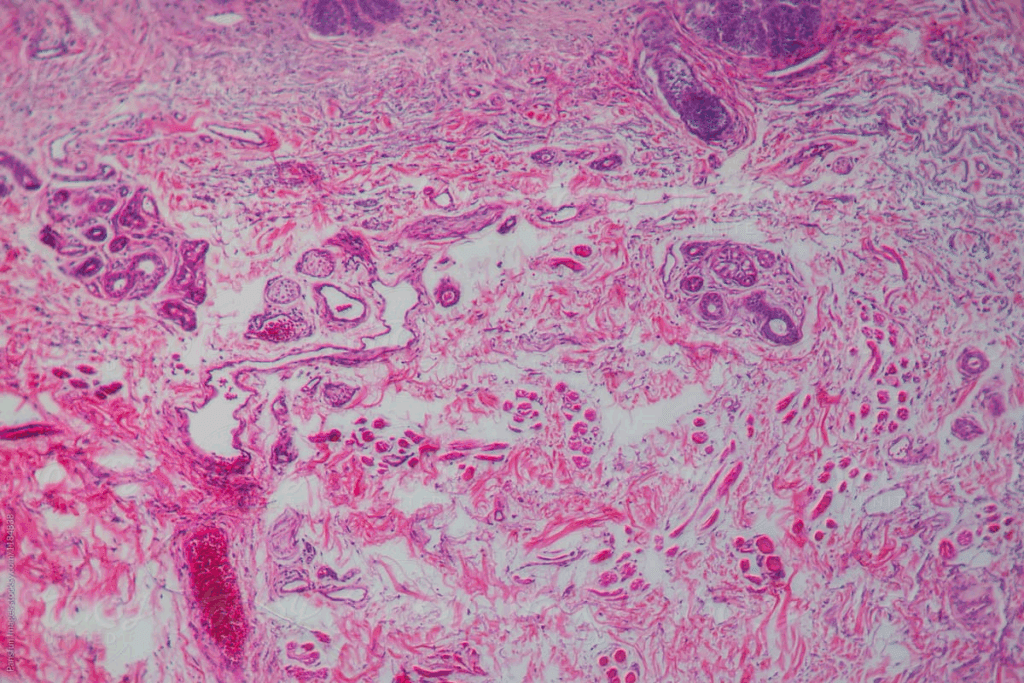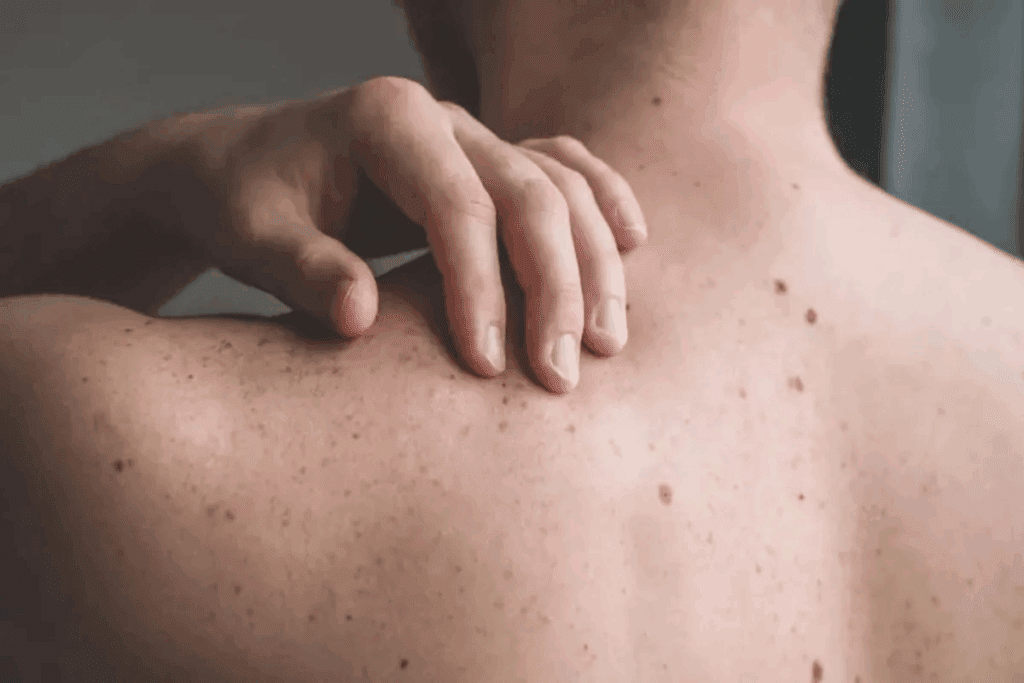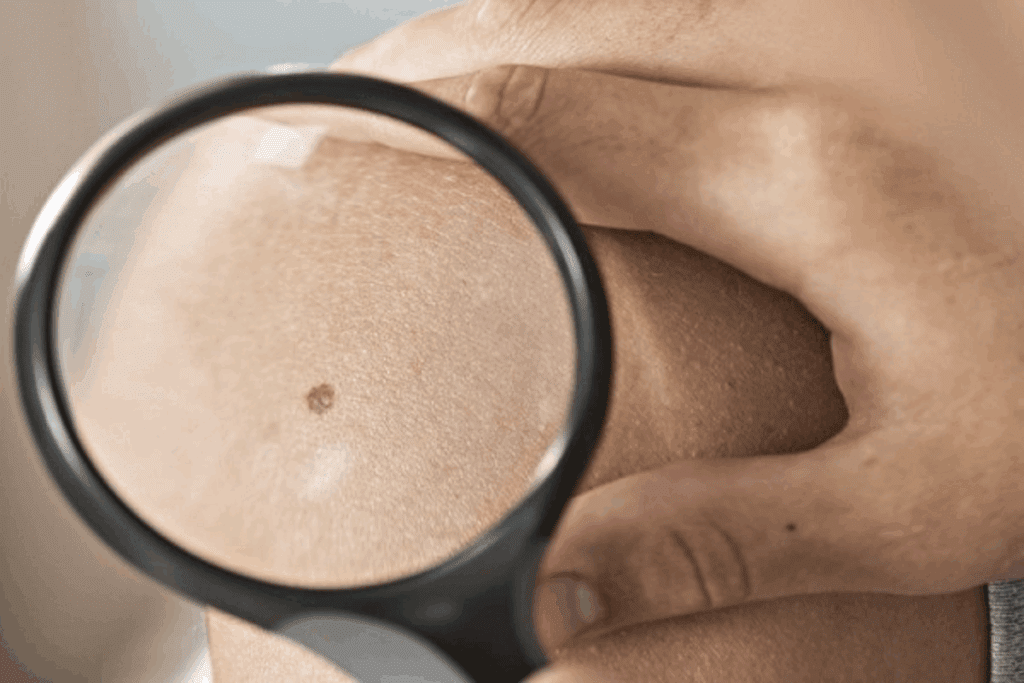Last Updated on November 27, 2025 by Ugurkan Demir

Basal cell carcinoma (BCC) is the most common skin skin cancer. It’s diagnosed in about 3.6 million people in the United States each year.
About 80 percent of all non-melanoma skin cancers are basal cell carcinomas. They often show up on sun-exposed areas like the face.
On white skin, BCC usually looks like a bump that’s the same color as the skin or pink. It’s important to know the signs of BCC to catch it early.
At Liv Hospital, we offer top-notch dermatological care and the latest diagnostic tools. We help patients find and treat BCC early, before it gets worse.

It’s key to know about basal cell carcinoma to spot its signs early and stop it from getting worse. This skin cancer starts in the basal cells at the skin’s bottom layer, called the epidermis.
Basal cell carcinoma begins in the basal cells, which make new skin cells. It’s mainly caused by UV light from the sun or tanning beds. Most cases happen on sun-exposed areas like the head, neck, and face.
Basal cell carcinoma is the most common skin cancer, making up a big part of all cases. It affects many people around the world each year. It’s more common in those who spend a lot of time in the sun and have fair skin.
| Population Group | Incidence Rate | Commonly Affected Areas |
| Fair-skinned individuals | High | Head, neck, face |
| Dark-skinned individuals | Low | Less common areas |
Several things can make you more likely to get basal cell carcinoma. These include:
Knowing these risk factors and what basal cell carcinoma is can help you prevent it. It also helps you get diagnosed and treated early.

Basal cell carcinoma often shows up on sun-exposed parts of the body. It’s linked to UV radiation from the sun or tanning beds. Knowing where it usually appears helps in catching it early.
The head, neck, and face are top spots for basal cell carcinoma. These areas get more sun, leading to UV damage. Nodular basal cell carcinoma looks like a pearly or flesh-colored bump here. Keep an eye out for new or changing spots.
Basal cell carcinoma can also pop up on the trunk and limbs, though less often. Superficial basal cell carcinoma shows up as flat, red patches on the trunk. Don’t skip these areas when checking yourself. For example, “skin cancer on fingers pictures” can help spot it on hands.
Basal cell carcinoma can show up in sun-protected spots like the genitals or under heavy clothes. These cases are rare but tricky to spot. Knowing these unusual spots helps find basal cell carcinoma in places like the stomach or back.
It’s key to know where basal cell carcinoma can appear for good skin health. Regular self-checks and doctor visits can lead to early detection and better treatment.
It’s important to know about the different types of Basal Cell Carcinoma. This is because each type has its own look and treatment needs. Basal Cell Carcinoma (BCC) is a skin cancer with many subtypes.
Nodular Basal Cell Carcinoma is the most common type. It looks like a firm, round bump that’s shiny and pink or red. These bumps can be clear, showing blood vessels, and might bleed when touched.
Superficial Basal Cell Carcinoma is flat and firm. It’s often pale or red and can be found on the trunk and arms. It can look like other skin issues, making it hard to diagnose.
There are other types like Morpheaform (or Sclerodermiform) BCC, which looks like a scar. Infiltrating BCC grows quickly. Knowing about these types helps doctors choose the right treatment.
| Subtype | Common Locations | Visual Characteristics |
| Nodular BCC | Head, Neck, Face | Firm, round, raised, shiny, pink or red |
| Superficial BCC | Trunk, Extremities | Flat, firm, pale or red areas |
| Morpheaform BCC | Face | Scar-like, firm, yellowish |
Knowing the different types of Basal Cell Carcinoma is key to catching it early. If you notice any unusual skin changes, see a dermatologist right away.
Basal cell carcinoma can start as small, pearly or waxy bumps. These bumps look shiny and can be translucent. This means you can see through them a bit.
The bumps have a shiny look and feel. They can be:
These bumps often show up in sun-exposed areas. They can be found in:
A light pink spot on the scalp or a small skin cancer on the face could be basal cell carcinoma early on.
You should worry if you see any of these signs:
| Characteristic | Description | Concern Level |
| Growth or Change | Rapid growth or change in size | High |
| Bleeding | Bleeding after minor trauma | Moderate to High |
| Pain or Discomfort | Persistent pain or discomfort | Moderate |
It’s important to catch it early. If you see unusual skin changes, like a dark spot skin cancer, see a dermatologist right away.
Flat, firm, pale or red skin spots can be a sign of basal cell carcinoma, a common skin cancer. These spots can look like flat, scaly patches with or without a raised edge. They can grow quite large over time.
The look of these flat, firm spots can vary. They might be pale, pink, or red. Sometimes, they can look like other skin issues. It’s important to watch for any skin changes, like a patch that won’t heal.
Key characteristics to look out for include:
These spots can grow slowly, often without early symptoms. As they grow, they may become more noticeable. It’s important to watch for any skin changes, as catching them early is key to treatment.
Basal cell carcinoma can make spots more defined over time. They might get a raised edge or have an ulcer in the center. Regular checks and professional advice are essential.
It can be hard to tell basal cell carcinoma from other skin issues like eczema or psoriasis. Basal cell carcinoma tends to stick around and not respond well to usual treatments.
If you see a flat, firm, pale or red spot on your skin that doesn’t go away or grows, see a dermatologist. They can check it out and might suggest a biopsy to figure out what it is.
Basal cell cancer can show up as small, raised lesions that bleed easily. These lesions might not look like cancer at first.
These lesions are usually small, less than 1 cm in size. They can look like pearly white or pink bumps, more noticeable on white skin. Their surface might be smooth or slightly scaly.
It’s important to watch any new or changing skin spots. Catching them early is key to treating them well. If you see a small bump that doesn’t go away or grows, see a dermatologist.
These lesions often bleed after minor injuries, like scratching or rubbing against clothes. This bleeding is a big warning sign.
Basal cell carcinoma lesions are fragile and bleed easily because they have a lot of blood and are close to the skin’s surface. If a lesion bleeds a lot, get medical help.
There are other signs to look out for in potentially cancerous lesions. These include:
Being alert to these signs and getting a doctor’s opinion if you notice anything unusual can greatly help in treating basal cell carcinoma.
Basal cell carcinoma shows up in many ways, making it key to know its forms. It’s the most common skin cancer. It can look like a firm, round growth, a circle that dips in the middle, or a scaly spot.
It often pops up on sun-exposed spots like the face and scalp. On the face, it might look like a pearly or waxy bump with blood vessels. On the scalp, it’s a firm, raised lesion that bleeds easily.
Basal cell carcinoma can also show up on fingers and arms, though it’s less common. On fingers, it’s a small, painless nodule. On arms, it’s a flat, firm area that’s pale or red.
On the trunk and back, it’s harder to spot because of the bigger area and different skin tones. It might look like a scaly patch or a circle-shaped lesion with a depressed center.
Knowing these different looks helps us spot basal cell carcinoma early. This makes it easier to treat.
One of the most telling signs of basal cell carcinoma is the appearance of open sores that refuse to heal. These sores can look like they’re healing, but then come back. This is a big worry because it might mean there’s a tumor.
Ulcerated basal cell carcinomas show up as open sores. These sores can bleed, ooze, or crust over. They often pop up on sun-exposed areas like the face, head, and neck. Early detection is key to stop the cancer from getting worse.
If you have an open sore that doesn’t heal in a few weeks, see a dermatologist. A sore that lasts more than three weeks is a worry sign. Quick medical check-up can tell if it’s cancer.
To spot if an open sore is basal cell carcinoma, look for certain signs. Sores that bleed easily, are painful, or have raised edges are red flags. Also, watch for sores that seem to heal but then come back. If you see these, get a doctor’s check-up.
Knowing the signs of basal cell carcinoma, like open sores, helps you get medical help early. This way, you can take care of your skin and catch cancer early.
Unusual growth patterns, like those with rolled edges or color changes, might signal basal cell carcinoma. This type of skin cancer can show up in many ways. It’s important to know the different signs.
Basal cell carcinoma often has growths with rolled edges and irregular borders. These can look like bumps or lesions with curled edges. Such signs should prompt you to get them checked out.
Basal cell carcinoma can also show color changes or variations. These might include different shades of brown, black, or pinkish hues. It’s key to watch for any new or changing pigmentation.
A dark spot on the skin could be a sign of skin cancer, like basal cell carcinoma. If you see any unusual skin changes, it’s important to see a dermatologist.
Morpheaform basal cell carcinoma looks like a scar-like area. It’s a firm, white, or yellowish patch that might look like a scar. But it’s a type of basal cell carcinoma that needs medical attention.
Knowing these signs can help catch skin cancer early. If you see any of these characteristics, it’s vital to see a healthcare professional for an evaluation and care.
Early detection and treatment are key to managing basal cell carcinoma well. We’ve talked about the signs and looks of basal cell cancer. These include pearly or waxy bumps, flat firm areas, and small raised lesions that bleed easily. Looking at basal cell cancer pictures and images of skin cancer can help you spot warning signs.
If you notice a spot or growth on your skin, it’s important to see a board-certified dermatologist. They can check your skin, give a proper diagnosis, and suggest the right next steps. Knowing what to look for and when to get help can greatly improve treatment results.
Understanding what sun cancer looks like and knowing the risk factors can help protect your skin. By being careful and getting medical help when needed, you can manage and treat basal cell carcinoma effectively.
Basal cell carcinoma can show up in different ways. You might see pearly or waxy bumps. Or flat, firm, pale or red areas. It can also be small raised lesions that bleed easily.
Other signs include open sores that don’t heal and growths with unusual looks.
It often shows up on sun-exposed areas. This includes the head, neck, face, trunk, and extremities. But it can also appear in less common spots.
On the face, it might look like a pearly or waxy bump. Or a flat, firm, pale or red area. It could also be a small raised lesion that bleeds easily.It might look like an open sore that doesn’t heal. Or a growth with unusual characteristics.
Skin cancer on the scalp might look like a new or changing growth. Or a sore that doesn’t heal. It could also be a patch of skin that’s red, pink, or shiny.It’s important to watch for any changes on your scalp. If you’re worried, see a dermatologist.
There are three main types: nodular, superficial, and morpheaform. Each type looks different. Knowing these differences helps doctors diagnose and treat it right.
Yes, it can happen on the fingers or arms. But it’s less common than on sun-exposed areas. If you notice a new or changing growth, get it checked by a dermatologist.
A dermatologist needs to examine it closely. They’ll look at the size, shape, and other details. This helps them figure out what it is and how to treat it.
If you see something that looks off, see a dermatologist. They’ll check it out and tell you what to do next. This could mean a diagnosis and treatment plan.
Yes, there are many pictures online. They show how basal cell carcinoma can look. These images can help you recognize it and know what to look for.
Finding it early is key to treating it well. The sooner it’s caught, the better the treatment chances. This also helps avoid serious problems later on.
National Center for Biotechnology Information. (2025). 7 Signs of Basal Cell Cancer Pictures. Retrieved from https://pmc.ncbi.nlm.nih.gov/articles/PMC11720226
Subscribe to our e-newsletter to stay informed about the latest innovations in the world of health and exclusive offers!